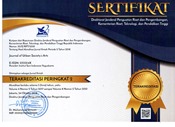The Development of a Performance Anxiety Scale for Theatre Actor
Abstract
Anxiety is the main barrier for an actor to give a perfect performance that determines the show’s overall quality. However, there have been no studies examining performance anxiety in theatre actors, especially in Indonesia. This study aims to develop a psychological scale that measures the actor’s performance anxiety level. The following five steps are carried out: (a) preparing the items based on the performance-only type of social anxiety; (b) checking content validity using Aiken's V method; (c) conducting a trial scale; (d) testing reliability using Cronbach's alpha; and (e) selecting items. One hundred sixty-three (163) theatre actors were given the Performance Anxiety Scale for Theatre Actors, which consists of 44 items. The analysis showed that Cronbach's alpha coefficient was 0.953 out of 38 passed items (r ≥ 0.30). Thus, the developed Performance Anxiety Scale for Theatre Actors has a good validity and reliability score and can be used properly.
Keywords
References
Abel, J. L., & Larkin, K. T. (1990). Anticipation of Performance Among Musicians: Psychological Arousal, Confidence, and State-Anxiety. Psychology of Music, 18, 171–182. https://doi.org/https://doi.org/10.1177%2F0305735690182006
American Psychiatric Association. (2013). Diagnostic and statistical manual of mental disorders (5th ed.). American Psychiatric Association.
APA Dictionary of Psychology. (2015). In G. R. VandenBos (Ed.), Dictionary of the old low and central Franconian psalms and glosses (2nd ed.). American Psychological Association. https://doi.org/10.1515/9783111704227.1
Azwar, S. (2012). Penyusunan Skala Psikologi (2nd ed.). Pustaka Pelajar.
Buchanan, T. W., Laures-Gore, J. S., & Duff, M. C. (2014). Acute stress reduces speech fluency. Biological Psychology, 97(1), 60–66. https://doi.org/10.1016/j.biopsycho.2014.02.005
Clark, D. B., & Agras, W. S. (1991). The Assessment and Treatment of Performance Anxiety in Musicians. Am J Psychiatry, 148(May), 598–605. https://doi.org/doi: 10.1176/ajp.148.5.598.
Cupido, C. (2018). Music Performance Anxiety, Perfectionism and Its Manifestation in the Lived Experiences of Singer-Teachers. Muziki, 15(1), 14–36. https://doi.org/10.1080/18125980.2018.1467367
de Vente, W., Madjandzic, M., & Bogels, S. (2014). The Pathophysiology of Social Anxiety. In J. W. Weeks (Ed.), The Wiley Handbook of Social Anxiety Disorder. Wiley-Blackwell.
Dobos, B., Piko, B. F., & Kenny, D. T. (2019). Music performance anxiety and its relationship with social phobia and dimensions of perfectionism. Research Studies in Music Education, 41(3), 310–326. https://doi.org/10.1177/1321103X18804295
Doğan, P. K. (2018). Examining the Relation Between the Fear of Negative Evaluation and the Anxiety for Social Appearance in Folk Dancers. Journal of Education and Training Studies, 6(3), 59–65. https://doi.org/10.11114/jets.v6i3.2916
Fishbein, M., Middlestadt, S. E., Ottati, V., Straus, S., & Ellis, A. (1988). Medical problems among ICSOM musicians: overview of a national survey. Medical Problems of Performing Artists, 3(1), 1–8. http://www.sciandmed.com/mppa/journalviewer.aspx?issue=1145&article=1451&action=3%5Cnpapers3://publication/uuid/92C09D53-9B87-477D-A622-67F201EF17D8
Ford, J. L., Ildefonso, K., Jones, M. L., & Arvinen-Barrow, M. (2017). Sport-related anxiety: current insights. Journal of Sports Medicine, 8, 205–212. https://doi.org/https://dx.doi.org/10.2147%2FOAJSM.S125845
Fortier, M. (1997). Theory / Theatre. Routledge.
Guyon, A. J. A. A., Studer, R. K., Hildebrandt, H., Horsch, A., Nater, U. M., & Gomez, P. (2020). Music performance anxiety from the challenge and threat perspective : psychophysiological and performance outcomes. BMC Psychology, 8(87), 1–13. https://doi.org/https://doi.org/10.1186/s40359-020-00448-8
Hadi, S. (2016). Metodologi Riset. Pustaka Pelajar.
Johnston, S. A., Roskowski, C., He, Z., Kong, L., & Chen, W. (2020). Effects of team sports on anxiety, depression, perceived stress, and sleep quality in college students. Journal of American College Health, 1–7. https://doi.org/10.1080/07448481.2019.1707836
Kantor-Martynuska, J., & Kenny, D. T. (2018). Psychometric properties of the Kenny-Music Performance Anxiety Inventory modified for general performance anxiety. Polish Psychological Bulletin, 49(3), 332–343. https://doi.org/10.24425/119500
Kurniawan, T. U. (2016). Perwujudan Naskah Drama Anusapati Karya S.H. Mintardja dalam Pementasan Teater. Journal of Urban Society’s Arts, 3(2), 73–81. https://doi.org/10.24821/jousa.v3i2.1476
Lemasson, A., André, V., Boudard, M., Lippi, D., & Hausberger, M. (2018). Audience size influences actors’ anxiety and associated postures on stage. Behavioural Processes, 157(September), 225–229. https://doi.org/10.1016/j.beproc.2018.10.003
Lindner, P., Dagöö, J., Hamilton, W., Miloff, A., Andersson, G., Schill, A., & Carlbring, P. (2021). Virtual Reality exposure therapy for public speaking anxiety in routine care: a single-subject effectiveness trial. Cognitive Behaviour Therapy, 50(1), 67–87. https://doi.org/10.1080/16506073.2020.1795240
MacAfee, E., & Comeau, G. (2020). Exploring music performance anxiety, self-efficacy, performance quality, and behavioural anxiety within a self-modelling intervention for young musicians. Music Education Research, 22(4), 457–477. https://doi.org/10.1080/14613808.2020.1781074
Marchant-Haycox, S. E., & Wilson, G. D. (1992). AND STRESS. Person. Individ. Diff, 13, 1061–1068. https://doi.org/doi:10.1016/0191-8869(92)90021-g
McGaw, C., Stilson, K. L., & Clark, L. D. (2007). Acting Is Believing (11th ed.). Wadsworth.
Merriam Webster’s Advanced Learner’s English Dictionary. (2008). Merriam-Webster Inc.
Monsma, E., Mensch, J., & Farroll, J. (2009). Keeping your head in the game: Sport-specific imagery and anxiety among injured athletes. Journal of Athletic Training, 44(4), 410–417. https://doi.org/10.4085/1062-6050-44.4.410
Nurcahyono, W. (2017). Penciptaan Teater “Jaka Kembang Kuning.” Journal of Urban Society’s Arts, 4(2), 110–122. https://doi.org/10.24821/jousa.v4i2.2164
Orzechowicz, D. (2008). Two on Emotional Management. Social Psychology Quarterly, 71(2), 143–156. https://doi.org/https://doi.org/10.1177/019027250807100204
Osborne, M. S., & Kenny, D. T. (2008). The role of sensitizing experiences in music performance anxiety in adolescent musicians. Psychology of Music, 36(4), 447–462. https://doi.org/10.1177/0305735607086051
Patel, A., & Hinton, D. (2020). Two Peas in a Pod? Understanding Cross-Cultural Similarities and Differences in Anxiety Disorders. In E. Biu, M. E. Charney, & A. W. Baker (Eds.), Clinical Handbook of Anxiety Disorders From Theory to Practice. Humana Press.
Serra, M. M., Spadafora, L. S., Valle, A. A., Coll, E. F., & de Ves, S. G. (2020). Student Moods Before and After Body Expression and Dance Assessments. Gender Perspective. Frontiers in Psychology, 11. https://doi.org/10.3389/fpsyg.2020.612811
Spahn, C. (2015). Treatment and prevention of music performance anxiety. Progress in Brain Research, 129–140. https://doi.org/10.1016/bs.pbr.2014.11.024
Spokas, M. E., & Cardaciotto, L. (2014). Heterogeneity Within Social Anxiety Disorder. In J. W. Weeks (Ed.), Blackwell Handbook of Social Anxiety Disorder. Wiley-Blackwell.
Stein, M. B., Walker, J. R., & Forde, D. R. (1996). Public-Speaking Fears in a Community Sample. Arch Gen Psychiatry, 53(2), 169–174. https://doi.org/doi:10.1001/archpsyc.1996.01830020087010
Steptoe, A., Malik, F., Pay, C., Pearson, P., Price, C., & Win, Z. (1995). The impact of stage fright on student actors. British Journal of Psychology, 86, 27–39. https://doi.org/doi:10.1111/j.2044-8295.1995.tb02544.x
Strasberg, L., & Schechner, R. (1964). Working with Live Material. The Tulane Drama Review, 9(1), 117–135. http://www.jstor.org/stable/1124784
Studer, R., Gomez, P., Hildebrandt, H., Arial, M., & Danuser, B. (2011). Stage fright : its experience as a problem and coping with it. Int Arch Occup Environ Health, 84, 761–771. https://doi.org/10.1007/s00420-010-0608-1
Stupar-Rutenfrans, S., Ketelaars, L. E. H., & Van Gisbergen, M. S. (2017). Beat the Fear of Public Speaking: Mobile 360° Video Virtual Reality Exposure Training in Home Environment Reduces Public Speaking Anxiety. Cyberpsychology, Behavior, and Social Networking, 20(10), 624–633. https://doi.org/https://doi.org/10.1089/cyber.2017.0174
Tsang, A. (2020). The relationship between tertiary-level students’ self-perceived presentation delivery and public speaking anxiety: A mixed-methods study. Assessment and Evaluation in Higher Education, 45(7), 1060–1072. https://doi.org/10.1080/02602938.2020.1718601
Wesner, R. B., Noyes, R., & Davis, T. L. (1990). The occurrence of performance anxiety among musicians. Journal of Affective Disorders, 18, 177–185. https://doi.org/https://doi.org/10.1016/0165-0327(90)90034-6
DOI: https://doi.org/10.24821/jousa.v10i2.6852
Article Metrics
Abstract view : 0 timesRefbacks
- There are currently no refbacks.

This work is licensed under a Creative Commons Attribution 4.0 International License. ISSN 2355-2131 (print) | ISSN 2355-214X (online).







